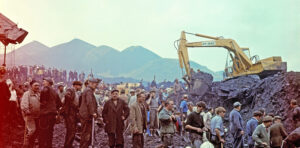Rising above the mouth of the vale of Neath, the smoke hangs over the village like a dejected memory, a tragic reminder of what will soon evaporate. The recently announced closure of the blast furnaces at the Port Talbot steelworks will devastate the local economy, resulting in the immediate loss of 2,800 jobs before it starts to take its toll on the wider community.
Many there will have paid little attention to the confirmation last week of a new leader of the Senedd. Vaughan Gething has often pinned his allegiances to the trade union movement. But will his attention, like so many before him, shift away from these industrial regions? On a joint visit to North Wales yesterday, Gething and Keir Starmer vowed to “turbocharge jobs and growth”, but how many in Port Talbot were listening? The steelworks’ fate represents more than just the closure of another foreign-owned company, the latest in a long line to vacate these towns. It signifies the final nail in the coffin of South Wales Industry.
This story reads all too familiar to people from this part of the Isles. Since the birth of industrialisation, the Valleys have been continuously weathered by a collective system of manufactured depression, which has shaped and damaged the psychological condition of the Nation. Indeed, the very first signs of what is now commonly referred to as the Great Depression can be traced back to the economic collapse witnessed in the Valleys of South Wales in the spring-to-summer period of 1924. While only 2% of the population was unemployed at the start of that year, the impact was so profound that, by August 1925, it had risen to a staggering 28.5%. While numerous factors contributed to this, two stood out, both products of the raw realities of global economic and political conflict.
The first was the Treaty of Versailles, whose terms required a defeated Germany to supply cheap coal to Europe as part of its reparations. As the British representative on the Council of Four, the Welshman David Lloyd George was thus a signatory to a settlement that effectively pulled the rug of profitability from under the South Wales coalfields: the price of Welsh coal fell by nearly 50%. The second was a turn in the United States to more exploitable markets for energy in the Southern Hemisphere. By the time the Wall Street Crash had bankers and investors jumping from buildings in 1929, the Valleys of South Wales already had 45% of its workforce conscripted into the army of the unemployed.
The use of the military metaphor is not unintentional. As some 241 pits closed by 1936, resulting in the now familiar pattern of outward migration form the region of the fit and able, the only moment of reprieve would be the outbreak of the Second World War, resulting in the need once again for the region’s coal to help motor to machineries of warfare. What must it do to the psychology of a people knowing the survival of their own communities was tied to the continuation of a war as local boys and men continued to fight and dig for yards back home?
If the Valleys were subject to abandonment and social neglect in the decades that followed, by the end of the Eighties and the defeat of the miners, it was clear the industrious way of life which once sustained these communities had been largely destroyed. Port Talbot was in many ways an exception to this, though it should be added that many of its workers were descendants of miners from nearby collieries and still tried to carry the socialist spirit of defiance, which was somewhat captured in Michael Sheen’s The Way.
Abjection would soon become a defining term, which could be routinely applied across the entire coal-face region. The figure of the hardened miner was replaced by the steroid-using gym worker, a grim contrast to the emaciated bodies seeking quiet refuge as they administered heroin into their dejected veins. Stories started to become more commonplace about adults and even teenagers taking their own lives. Soon we all knew of somebody who could no longer face the reality of an abandoned world. Like most things in the Valleys, the more time passes, the greater the problem becomes. And the realisation these towns were facing a suicide epidemic captured international media attention in 2008, as the tragic loss of so many young teens in quick succession within a 10-mile radius of Bridgend led many to question the causes and possible solutions.
Government statistics continue to document rising numbers of suicide, with Wales home to the highest percentage of any region in the United Kingdom. While the most convenient explanation for this often focuses upon the mental health of the afflicted, and invariably advocates more therapy and intervention at an individual level, less attention has been given to the idea that depression should first and foremost be seen as a social phenomenon — that is also inseparable from the lived conditions, the ecologies and atmospheres, into which a community is thrown.
Having said this, what is also peculiar about the Valleys is how the exponential rise in suicide corresponds to the regreening of the landscape, posing a direct challenge to those who primarily correlate wellbeing with environmental recovery. Recovery means nothing if people feel like they have no value or purpose to their existence, regardless of how many daffodils are growing.
While suicides among young girls (as in Bridgend) have become a growing problem — indeed I have lost two cousins this way — it is the vast rise in young male suicides that registers as the most pressing of concerns. Again, while there are many explanations offered for this, given how the figures compare to other social groups (notably black and Asian), surely such a phenomenon can only be properly explained by attending to the crisis of white male subjectivity.
Today, what we look upon are social systems in which young white men are struggling to find any meaning let alone political agency. As other groups are being encouraged to find a sense of purpose and belonging through a shared sense of historical outrage, such an identity has been denied them. The same men have also been thrown into a cultural milieu in which they are being asked to embrace their vulnerabilities, while stripping them of the very qualities of passion and fight that might allow them to deal with difficult times. Should they have the gall to question the status quo, often they are accused of exhibiting white male fragility, which is a rather peculiar way of defaulting back to a desired framing of brokenness.
Because people are not born vulnerable. Systems produce them that way. And if there is a violence to speak of today in places like the Valleys, it’s not one of masculine hardness — it’s a violence of the vulnerable.
Young white men are continually being told they should aspire to whatever the new digital world has to offer, knowing full well to be born in the Valleys means the chances of escape are less with each rotation of the clock. This reminds of how static the empty time of social depression can truly be. Yet still some have the temerity to call them privileged. If such a word has any meaning, it should be linked to the luxury of time — or to properly separate those who inhabit a dead time that has no prospect versus those with the luxury of time to fire off social-media missives, day after day, without it having any impact on their material welfare.
Back in Port Talbot, meanwhile, as the spring rains fall and the furnaces that give life to the town are slowly doused, it’s hard not to be pessimistic. If a century of mass industrial closure has seen very little to replace it, the speeding up of automation and artificial intelligence promises to leave farther behind those who weren’t even at the starting line to begin with. Faced with these conditions of social depression, should we be surprised when desperate young men try to find a lasting way out? I know personally what it’s like to live through seasons marked by the weight of absence. It’s suffocating. It’s debilitating. And it’s soul-destroying.
***
Disclaimer
Some of the posts we share are controversial and we do not necessarily agree with them in the whole extend. Sometimes we agree with the content or part of it but we do not agree with the narration or language. Nevertheless we find them somehow interesting, valuable and/or informative or we share them, because we strongly believe in freedom of speech, free press and journalism. We strongly encourage you to have a critical approach to all the content, do your own research and analysis to build your own opinion.
We would be glad to have your feedback.
Source: UnHerd Read the original article here: https://unherd.com/



